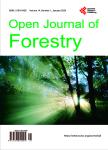Using Biophysical Variables and Stand Density to Estimate Growth and Yield of <i>Pinus patula</i>in Antioquia, Colombia
Using Biophysical Variables and Stand Density to Estimate Growth and Yield of <i>Pinus patula</i>in Antioquia, Colombia作者机构:Plantation Management Research Cooperative Warnell School of Forestry and Natural Resources University of Georgia Athens GA USA Universidad Nacional de Colombia Medellín Colombia
出 版 物:《Open Journal of Forestry》 (林学期刊(英文))
年 卷 期:2019年第9卷第3期
页 面:195-213页
学科分类:1002[医学-临床医学] 100214[医学-肿瘤学] 10[医学]
主 题:Von Bertalanffy Chapman-Richards Fixed-Effect Models Forest Productivity Mexican Pine Mean Annual Increment
摘 要:Timberland investment opportunities in Colombia are expected to increase as a result of the peace agreement recently signed between the Colombian government and the Revolutionary Armed Forces of Colombia. This new socio-political environment may facilitate the expansion of commercial forest plantations on a wider range of site conditions that are currently considered in existing biometric tools. Data from 1119 temporary plots of unthinned, unmanaged, and genetically unimproved Pinus patula plantations in the Antioquia region were combined with a large set of biophysical attributes to identify spatial variation in yield. A wide array of biophysical covariates was explored to characterize the most favorable environmental conditions for the species, and to identify potential explanatory variables to be included in forest yield models. The mathematical form of the model is the von Bertalanffy-Chapman-Richards type, with parameters: asymptote, intrinsic growth rate and allometric constant. The parameters were expressed as linear functions of soil pH, terrain slope, the mean annual temperature to mean annual precipitation ratio, and stand density. The statistical contribution of selected covariates was evaluated using the likelihood ratio test. The model was validated using an independent set of 133 observations. The spatial representation of the model depicts the timber production potential and allows for the identification of the most suitable geographical areas to establish Pinus patula plantations in Antioquia, Colombia. The estimated yield model provides a reliable baseline for timber production, and insight into timberland investments in Colombia.



